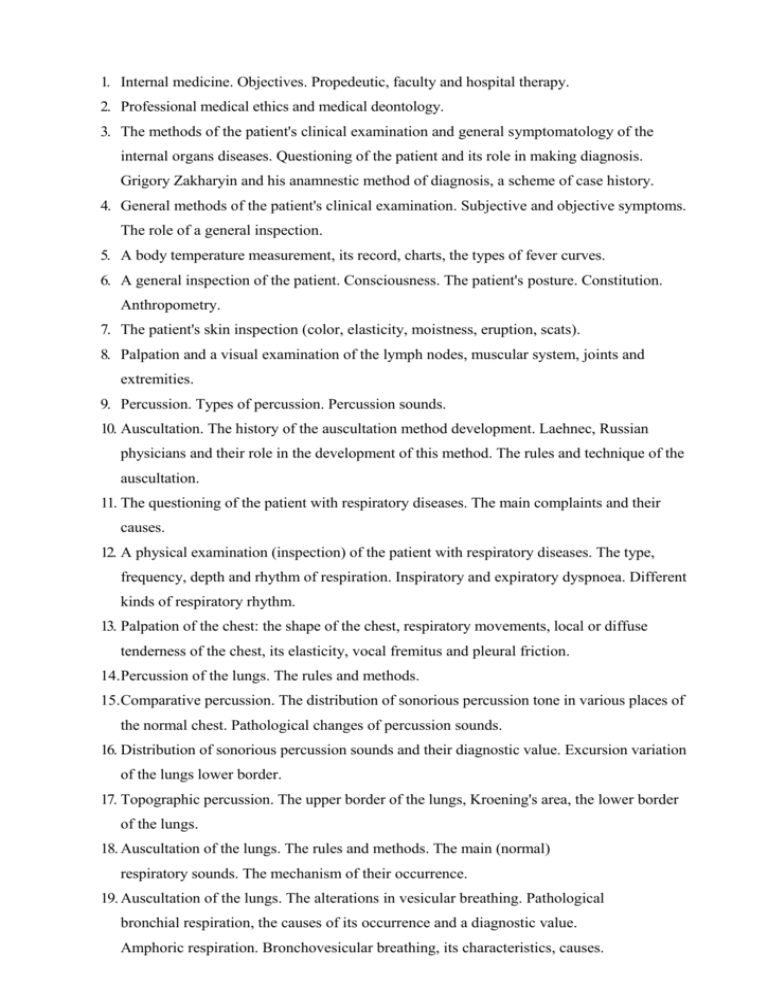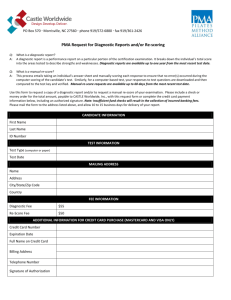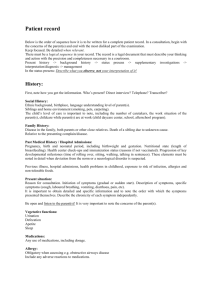Internal medicine. Objectives. Propedeutic, faculty and hospital
advertisement

1. Internal medicine. Objectives. Propedeutic, faculty and hospital therapy. 2. Professional medical ethics and medical deontology. 3. The methods of the patient's clinical examination and general symptomatology of the internal organs diseases. Questioning of the patient and its role in making diagnosis. Grigory Zakharyin and his anamnestic method of diagnosis, a scheme of case history. 4. General methods of the patient's clinical examination. Subjective and objective symptoms. The role of a general inspection. 5. A body temperature measurement, its record, charts, the types of fever curves. 6. A general inspection of the patient. Consciousness. The patient's posture. Constitution. Anthropometry. 7. The patient's skin inspection (color, elasticity, moistness, eruption, scats). 8. Palpation and a visual examination of the lymph nodes, muscular system, joints and extremities. 9. Percussion. Types of percussion. Percussion sounds. 10. Auscultation. The history of the auscultation method development. Laehnec, Russian physicians and their role in the development of this method. The rules and technique of the auscultation. 11. The questioning of the patient with respiratory diseases. The main complaints and their causes. 12. A physical examination (inspection) of the patient with respiratory diseases. The type, frequency, depth and rhythm of respiration. Inspiratory and expiratory dyspnoea. Different kinds of respiratory rhythm. 13. Palpation of the chest: the shape of the chest, respiratory movements, local or diffuse tenderness of the chest, its elasticity, vocal fremitus and pleural friction. 14.Percussion of the lungs. The rules and methods. 15.Comparative percussion. The distribution of sonorious percussion tone in various places of the normal chest. Pathological changes of percussion sounds. 16. Distribution of sonorious percussion sounds and their diagnostic value. Excursion variation of the lungs lower border. 17. Topographic percussion. The upper border of the lungs, Kroening's area, the lower border of the lungs. 18. Auscultation of the lungs. The rules and methods. The main (normal) respiratory sounds. The mechanism of their occurrence. 19. Auscultation of the lungs. The alterations in vesicular breathing. Pathological bronchial respiration, the causes of its occurrence and a diagnostic value. Amphoric respiration. Bronchovesicular breathing, its characteristics, causes. 20. Auscultation of the lungs. Adventitious sounds: rales, crepitation. The mechanism of their occurrence, a diagnostic value. 21. Auscultation of the lungs, dry and moist rales. The mechanism of crepitation and pleural friction, a diagnostic value. 22.Bronchophony, vocal fremitus. The diagnostic value of their intensity and weakness. Pleural friction. 23. Roentgenoscopy, roentgenography, tomography. Bronchoscopy. The examination of bronchial mucosa, the biopsy of the lungs, pleura. The enlargement of tracheobronchial lymph nodes. The study of pleural washings. 24. The functional studies of external respiratory system. Spirography. The respiratory volume and capacity, their diagnostic value. Tiffno test. 25. The physical findings of focal consolidation syndrome of the pulmonary tissue. The cavity in lungs and pneumothorax. 26. The bronchial obstruction syndrome. The diagnostic value. Instrumental examination. 27. Bronchial asthma. Etiology and pathogenesis. A clinical picture, complications. 28. Acute and chronic bronchitis. A clinical picture. A clinical value of pneumotachometry. 29. Fluid and air accumulation syndrome in the pleural cavity. Hydrothorax and pneumothorax. 30. Pleurisy. Classification. Pleurisy with effusion. Fluid and air syndrome in the pleural cavity. Physico-chemical and microscopic studies of the pleural fluid. 31. A cavity syndrome in the lungs. A clinical picture. Pulmonary abscess, bronchiectasis, lung tumor. Clinical symptoms. 32. Emphysema of the lungs. Etiology and pathogenesis. Primary and secondary emphysema of the lungs. Obstructive emphysema. 33. Bronchopneumonia (focal pneumonia). Etiology and pathogenesis. A clinical picture, its course. 34. Acute lobar pneumonia. Etiology and pathogenesis. A clinical picture, its course, complications. 35.External respiratory dysfunction syndrome (acute and chronic). Ventilation disorders, the obstructive, restrictive, alveolar capillary block. The degree and stages of respiratory insufficiency. 36. Atelectasis. The stages of obstructive atelectasis. 37. The puncture of the pleural cavity. The purpose, method, indication and contraindication. Physico-chemical, cytological and bacteriological analyses. 38. The study of the sputum. General and special investigations of the sputum. The causes of color, smell changes. Sputum microscopic studies. 39. The heart failure in brochopulmonary disease. Chronic pulmonary heart syndrome. 40. The questioning of the patient with blood circulatory system diseases. Main complains, the mechanisms of their appearance. ! If 41. Inspection of the patient with the heart diseases. The patient's positions color of the skin. Cyanosis. The difference between cyanosis in patients with heart and lung diseases. Edema. 42. Dyspnoea. Main features of dyspnoea in patients with heart diseases.Cardiac asthma. First aid. 43. Edema in patients with cardiovascular pathology. The mechanisms of its appearance, localization, methods of its revealing, diagnostic value. Ascites. 44. Study of the peripheral vessels. Inspection, palpation, auscultation of the arteries. Inspection and palpation of the veins. Clinical significance. 45. Study of arterial pulse. Palpation of the pulse. Properties of the arterial pulse. 46. Inspection of the heart region: the apex beat, the cardiac beat, epigastric pulsation. Palpation of the heart region. Determination of systolic and diastolic thrill (cat's purr). Diagnostic significance. 47. Methods of blood pressure measuring. Korotkoff s method, blood pressure monitoring, its diagnostic significance. 48. Percussion of the heart. Determination of the relative and absolute cardiac dullness, the borders of the vascular bundle, the configuration of the heart. Diagnostic significance of the heart borders displacement. 49. Inspection of the neck vessels: swollen veins, positive and negative venous pulse. Difference between arterial and venous pulsation. Main mechanisms of their appearance. Diagnostic significance. Visual determination of central venous pressure. 50. Auscultation of the heart. Main rules for auscultation of the heart. Normal heart sounds, mechanisms of their appearance, their characteristics. The three-sound rhythm. 51.Auscultation of the heart. The sites of projection of the valves on the anterior chest and main auscultatory areas. Changes in the heart sounds: changes in the intensity, reduplication of the heart sounds. The additional heart sounds. The triple rhythm, gallop rhythm. 52. Auscultation of the arteries and veins. Nun's murmur. Traube's doubled tone. Vinogradov- Durozie's doubled murmur. . 53. Auscultation of the heart. Cardiac murmurs. Mechanisms of their appearance. Main auscultatory areas. Differentiation of functional and organic murmurs. 54. Cardiac murmurs. Classification of murmurs. Properties of murmurs. Diagnostic value. Main characteristics of murmurs appearing due to regurgitation of blood and stenosis of the orifice. 55.Laboratory examination of the patient with heart diseases. Main methods. Diagnostic significance. 56. Electrocardiography. Reading and interpreting the ECG. The ECG-main elements: waves, intervals, complexes. 57. X-ray study of the cardiovascular system. Diagnostic significance. Angiocardiography. Coronary angiography. 58. Rheumatic fever. Aetiology, pathogenesis, morphological picture. Clinical features (rheumatic polyarthritis, rheumatic endomyocarditis). Laboratory signs. Diagnostic criteria of rheumatic fever. 59. Bacterial endocarditis. Clinical picture. Modern diagnostic criteria. 60. Endocarditis. Rheumatic endomyocarditis. Main symptoms. 61.Stenosis ot the left atrioventricular orifice. Aetiology, haemodynamics, clinical features. Xray picture, ECG signs. 62. Mitral incompetence. Aetiology, haemodynamics, clinical features. X-ray picture, ECG sings, echocardiography data. 63. Diseases of the myocardium. Myocarditis. Aetiology, clinical picture. Cardiomyopathy. Cardiosclerosis. Clinical feature. Diagnostics. 64. Aortic incompetence. Aetiology, haemodynainiics. Clinical picture. ECG signs. 65. Aortic stenosis. Aetiology, haemodynamics, clinical picture. ECG signs. 66. Systemic arterial hypertension. Secondary symptomatic hypertension. Hypertensive crisis. First aid. 67. Essential hypertension. Aetiology and pathogenesis. Clinical picture. Classification. Complications. 68. Circulatory insufficiency. Heart failure. The main causes, haemodynamic changes. Clinical manifestation of heart failure. 69. Acute heart failure. The syndrome of acute left-ventricular heart failure. (Cardiac asthma, edema of the lungs. Clinical picture. Fist aid. The syndrome of acute right- ventricular hart failure. Aetiology, main clinical manifestation. 70. Chronic circulatory insufficiency. Aetiology and pathogenesis. Haemodynamic disorders. The stages of chronic circulatory insufficiency. 71. Acute vascular insufficiency (syncope, collapse, shock). The main causes. Mechanisms of the development. Clinical feature. j i 72. Acute pain in the heart, region. Differential diagnostics between acute attack of angina pectoris and cardialgia. Fist aid. 73. Atrial flutter. Aetiology, pathogenesis, clinical feature. The ECG pattern. 74. Paroxysmal atrial and ventricular tachycardia. Clinical picture. The FCG pattern. 75. Atrioventricular block. The ECG sings. Morgagni-Adams-Stokes syndrome. 76. Ectopic beats. Classification. Clinical feature. The ECG pattern. 77. Ischaemic heart diseases. Angina pectoris. Aetiology, pathogenesis. Clinical picture. Functional exercise tests indicating ischaemic heart diseases. 78. Acute coronary syndrome. 79.Atherosclerosis. Atherosclerosis of the coronary arteries. Cardiosclerosis, clinical features. Diagnostics. 80.Myocardial infarction. Aetiology, pathogenesis, clinical classification. The ECG sings. 81.Inquiry of patients with digestive system diseases. Main complains. 82.Inspection of the abdomen. Superficial palpation of t|e abdomen. Tenderness of the abdomen, the presence of muscular defense, Irritation of the peritoneum (Shchetkin-Blumberg symptom). 83. Deep sliding palpation (according to Obraztsov and Stfazhesko). A diagnostic significance of the findings obtained by palpation. 84. Examination of the stomach secretory function. Technique and the methods of gastric juice probing (basal secretion, stimulating secretion). Gastric juice acidity, hourly stomach secretion 85.Physical and chemical properties of gastric juice (determination of free and bound hydrochloric acid, total acidity). Hypersecretion and hyposecretion syndrome. Gastric secretion function in peptic ulcer disease and stomach cancer. 86.The methods of helicobacter pylori investigation (cytological, histological, immunological tests). 87.Gastric and duodenal ulcer. Etiology and pathogenesis. A clinical picture. Instrumental and laboratory investigations (gastric secretory function, gastroscopy, X-ray examination). Peptic ulcer disease complications. 88.Stomach cancer. Etiology, pathogenesis, a clinical picture. Instrumental and laboratory investigations. 89. Inquiry and physical examination of the patients with intestinal disease|. Chronic enteritis. Etiology, pathogenesis, a clinical picture. 90.Chronic colitis. Etiology, pathogenesis, a clinical picture. 91. An inadequate digestion syndrome. Etiology, pathogenesis, a clinical picture, methods of investigation. 92. An acute abdomen syndrome. Etiology, pathogenesis, clinical picture. | 93. Malabsorption syndrome. Etiology, pathogenesis, clinical picture, methods of investigation. 94. Coprological studies. A diagnostic significance of the main coprological sypdromes. 95. Gastritis (acute and chronic gastritis). Etiology, pathogenesis, clinical picture. Instrumental and laboratory investigations. 96. Duodenal contents study. A diagnostic significance of the duodenal contents findings. 97. Percussion and palpation of the liver. A diagnostic significance of the findings obtained by percussion and palpation of the liver. 98. Main laboratories syndromes in the liver diseases (cytolic, cholestasis, |hypersplenism). The investigation of the liver excretory and detoxicating function. The investigation of the liver pigmentary and protein metabolism. 99.Serological tests (hepatitis virus antigens and antibodies investigation). 100. Ultrasonography (echography) investigation of the liver, spleen, gall ibladder and common bile duct. Puncture biopsy of the liver, laparoscopy. X-Ray study of the gallbladder and bile dubits (cholecystography, cholangiography, cholangiopancreatography). Radioisotope methods of the |liver function and structure study (scanning, radioisotope hepatography). 101. Inquiry and physical examination of the patients with liver diseases. The main clinical syndromes. 102. Portal hypertention syndrome. The mechanism of ascites and peripheral oedema development. 103. Physical examination of the patients with gall bladder diseases. A diagnost|c significance of the findings obtained by palpation of the gall bladder. Main symptoms revealed in gall bladder diseases (Zakharynf s, Vasilenko's, Orthner's, de Mussy-Georgievsky symptoms). 104. Deranged bilirubin secretion. Jaundice (hemolytic, parenchymatous, obstructive types). Clinical, laboratory and instrumental methods of jaundice determination. 105. Chronic hepatitis. Etiology, pathogenesis, classification, a clinical picture. Instrumental and laboratory studies. 106. Hepatic insufficiency. Clinical signs. Laboratory tests. 107. Cholelithiasis. Etiology, pathogenesis, a clinical picture. Instrumental and laboratory investigations. Course and complications. 108. Pancreatitis (acute and chronic). Etiology, pathogenesis, a clinical picture, course. The main principles of the treatment. 109. Inquiry of the patients with kidneys diseases. Main complaints and their pathogenesis. 110. Examination of the patients with kidneys diseases (inspection, palpation of kidneys, Pastenatsky’s symptom). A diagnostic significance of the findings obtained by percussion and palpation of the kidneys. 111. Protein determination in urine. A diagnostic significance the selective and non- selective proteinuria. 112. The study of urinalysis (specific gravity, color, reaction of the urine, determination of protein in urine, microscopy of urine sediment). Estimation of urine pathological changes. 113. ]Zimnitsky's test. The rules of collection urine for Zimnitsky's test. The Rehberg test. Clinical estimation of the Zimnitsky and Rehberg tests result. 114. A diagnostic significance of X-Ray examination, ultrasonography of the kidneys, scanning and radioisotope nephrography. 115. Microscopy of urinary sediment. The estimation of urine pathological changes (Nechiporenko's method, Addis-Kakovsky test). Bacterioscopic and bacteriological studies of urine. 116. Renal edema (localization, determination, causes). 117. Acute glomerulonephritis. Etiology, pathogenesis, a clinical picture, course. 118. Chronic glomerulonephritis. Aetiology, pathogenesis, clinical picture. Instrumental and laboratory investigations. A diagnostic significance of kidney biopsy. 119. Pyelonephritis (acute and chronic). Etiology, pathogenesis, a clinical picture. Instrumental and laboratory investigations. 120. Renal eclampsia (clinical picture, the main principles of the treatment). 121. Nephrotic syndrome. Etiology, pathogenesis, a clinical picture, a laboratory investigation. Amyloidosis of the kidneys. 122. Renal failure. Clinical and laboratory diagnosis of the renal failure stages (periods). Uremic coma. 123. Acute renal failure. Etiology, a clinical picture, the main principles of the treatment. 124. Nephrolithiasis. Etiology, pathogenesis, a clinical picture, course and complications. A diagnostic significance of X-Ray examination, ultrasonography of the kidneys. 125. Thyroid gland disease, methods of examination. A hypothyroidism, the basic clinical signs. 126. A diffuse toxic goiter. An ethiology and a pathogeny. Clinical presentations. 127. Diabetes mellitus. An ethiology and a pathogeny. Clinical presentations. Complications. Glucose level estimation in blood, urine, quality and quantitative methods. 128. Diabetic and hypoglycemic coma. Clinical presentations. First aid. 129. Adrenal failure. A symptomatology. 130. Acute allergoses: urticaria, Quincke's disease, anaphylactic shock. 131. Nutritional and pituitary obesity. 132. The general description about hypo- and avitaminosises. 133. Inquiries of the patients with haemopoiesis pathology. The main patient’s complaints, their diagnostic value. 134. Examination of the patients with blood diseases. Inspection, palpation, percussion of a liver and a lien. A palpation of lymph nodes, procedure, diagnostic value of revealed changes. 135. Laboratory and instrumental methods of examination of the patients with blood diseases. Diagnostic value of sternal puncture, lymphonodus and trepanobiopsy. 136. General blood analysis. Diagnostic value of changes of parameters of a haemogram (change of a haemoglobin content, erythrocytes, a color index, the leukocytic blood count, ESR increase). 137. Erythrocyte count. Haemoglobin and blood color index. Erythrocyte sedimentation rate. Diagnostic value of these methods of a blood analysis. 138. The leukocytic formula and its changes at various internal diseases. Leukopenia, leukocytosis and leukemoid reaction. 139. The basic methods of research of coagulating and anticoagulative system of a blood. Autoimmune thrombocytopenias. 140. A hemorrhagic syndrome. The main bleeding diseases. Symptoms of hemorrhagic vasculites and haemophilia. 141. Anemias. The basic types. Complaints at various anemia types. Symptomatology and diagnostics of an acute and chronic posthemorrhagic anemia. 142. Iron deficiency anemia. Pathogeny, symptomatology, hematological pattern. General principles of treatment. 143. Pernicious anemia. Pathogeny, symptomatology. 144. The basic syndromes reflecting changes of system of a blood. Myeloproliferative and lymphoproliferative syndromes. Clinical presentations. 145. An acute leukosis. An etiology and a pathogeny. Classification. Clinical presentations, a pattern of a periphery blood. 146. A hematological pattern at a chronic lymphoid leukosis and a lymphogranulomatosis. Value of a puncture of a lymph node. 147. A myelosis. Clinic, a hematological pattern. Value of a sternal puncture. 148. A chronic lymphoid leukosis. Clinic, a hematological pattern. Value of a sternal puncture. 149. HIV-infection. Measures of prophylaxis. 150. Examination of patients with osteomuscular system and joints diseases. Inquiry. Physical methods of examination. 151. Articular syndrome. Its features at rheumatic disease and a pseudorheumatism. 152. Sudden death. Resuscitation actions. Artificial pulmonary ventilation, indirect cardiac massage. 153. Esophageal, stomach and intestinal bleedings. First aid.





